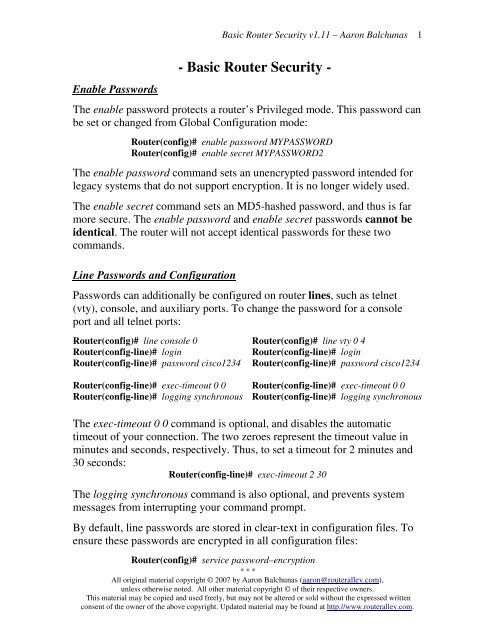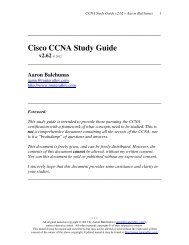Basic Router Security - Router Alley
Basic Router Security - Router Alley
Basic Router Security - Router Alley
You also want an ePaper? Increase the reach of your titles
YUMPU automatically turns print PDFs into web optimized ePapers that Google loves.
Enable Passwords<br />
<strong>Basic</strong> <strong>Router</strong> <strong>Security</strong> v1.11 – Aaron Balchunas<br />
- <strong>Basic</strong> <strong>Router</strong> <strong>Security</strong> -<br />
The enable password protects a router’s Privileged mode. This password can<br />
be set or changed from Global Configuration mode:<br />
<strong>Router</strong>(config)# enable password MYPASSWORD<br />
<strong>Router</strong>(config)# enable secret MYPASSWORD2<br />
The enable password command sets an unencrypted password intended for<br />
legacy systems that do not support encryption. It is no longer widely used.<br />
The enable secret command sets an MD5-hashed password, and thus is far<br />
more secure. The enable password and enable secret passwords cannot be<br />
identical. The router will not accept identical passwords for these two<br />
commands.<br />
Line Passwords and Configuration<br />
Passwords can additionally be configured on router lines, such as telnet<br />
(vty), console, and auxiliary ports. To change the password for a console<br />
port and all telnet ports:<br />
<strong>Router</strong>(config)# line console 0<br />
<strong>Router</strong>(config-line)# login<br />
<strong>Router</strong>(config-line)# password cisco1234<br />
<strong>Router</strong>(config-line)# exec-timeout 0 0<br />
<strong>Router</strong>(config-line)# logging synchronous<br />
<strong>Router</strong>(config)# line vty 0 4<br />
<strong>Router</strong>(config-line)# login<br />
<strong>Router</strong>(config-line)# password cisco1234<br />
<strong>Router</strong>(config-line)# exec-timeout 0 0<br />
<strong>Router</strong>(config-line)# logging synchronous<br />
The exec-timeout 0 0 command is optional, and disables the automatic<br />
timeout of your connection. The two zeroes represent the timeout value in<br />
minutes and seconds, respectively. Thus, to set a timeout for 2 minutes and<br />
30 seconds:<br />
<strong>Router</strong>(config-line)# exec-timeout 2 30<br />
The logging synchronous command is also optional, and prevents system<br />
messages from interrupting your command prompt.<br />
By default, line passwords are stored in clear-text in configuration files. To<br />
ensure these passwords are encrypted in all configuration files:<br />
<strong>Router</strong>(config)# service password–encryption<br />
* * *<br />
All original material copyright © 2007 by Aaron Balchunas (aaron@routeralley.com),<br />
unless otherwise noted. All other material copyright © of their respective owners.<br />
This material may be copied and used freely, but may not be altered or sold without the expressed written<br />
consent of the owner of the above copyright. Updated material may be found at http://www.routeralley.com.<br />
1
Disabling Unnecessary Services<br />
<strong>Basic</strong> <strong>Router</strong> <strong>Security</strong> v1.11 – Aaron Balchunas<br />
Cisco IOS devices support many services that may pose a risk to the<br />
network. These services, if unneeded, should be disabled. Additionally, any<br />
interfaces that are not being used should be disabled using the shutdown<br />
command:<br />
<strong>Router</strong>(config)# interface ethernet0<br />
<strong>Router</strong>(config-if)# shutdown<br />
BOOTP can be used by Cisco devices to load copies of the IOS to other<br />
Cisco devices, and is enabled by default. To disable this service:<br />
<strong>Router</strong>(config)# no ip bootp server<br />
CDP (Cisco Discovery Protocol) allows Cisco devices to “discover”<br />
information about other directly connected Cisco devices, and is enabled by<br />
default. CDP can be disabled either globally or on a per-interface level:<br />
<strong>Router</strong>(config)# no cdp run<br />
<strong>Router</strong>(config)# interface ethernet0<br />
<strong>Router</strong>(config-if)# no cdp enable<br />
Cisco devices can load their startup-configuration files from a remote FTP<br />
server, though this service is disabled by default. Either of the following<br />
commands will prevent the router from doing this:<br />
<strong>Router</strong>(config)# no boot network<br />
<strong>Router</strong>(config)# no service config<br />
If a device name or unrecognized command is typed into the IOS command<br />
line, the IOS will attempt to resolve the name using DNS. By default, the<br />
IOS will broadcast (255.255.255.255) this request. To specify a specific<br />
DNS server for name resolution:<br />
<strong>Router</strong>(config)# ip name-server 192.168.1.1<br />
DNS name resolution can be disabled if necessary:<br />
<strong>Router</strong>(config)# no ip domain-lookup<br />
* * *<br />
All original material copyright © 2007 by Aaron Balchunas (aaron@routeralley.com),<br />
unless otherwise noted. All other material copyright © of their respective owners.<br />
This material may be copied and used freely, but may not be altered or sold without the expressed written<br />
consent of the owner of the above copyright. Updated material may be found at http://www.routeralley.com.<br />
2
Disabling Unnecessary Services (continued)<br />
<strong>Basic</strong> <strong>Router</strong> <strong>Security</strong> v1.11 – Aaron Balchunas<br />
Cisco routers, as of IOS 11.3, can function as an FTP server. This can be<br />
useful to copy configuration files back and forth from your router. However,<br />
this could also allow an unauthorized person to gain access to the router file<br />
system. This service is disabled by default as of IOS 12.3. To manually<br />
disable this service:<br />
<strong>Router</strong>(config)# no ftp-server write-enable<br />
Earlier version of the IOS may use the following syntax:<br />
<strong>Router</strong>(config)# no ftp-server enable<br />
To disable the TFTP equivalent:<br />
<strong>Router</strong>(config)# no tftp-server flash<br />
The Finger service allows someone to query what users are logged into a<br />
device, and is enabled by default. This is the same information displayed<br />
when the show users command is inputted. To disable the finger service:<br />
<strong>Router</strong>(config)# no ip finger<br />
<strong>Router</strong>(config)# no service finger<br />
The Cisco IOS now supports a basic HTTP management interface.<br />
However, access to this interface should be regulated. If the HTTP interface<br />
is unnecessary, disable it using the following command:<br />
<strong>Router</strong>(config)# no ip http server<br />
A Cisco device can respond to an ICMP Mask Request, providing the<br />
requestor with the subnet mask of an interface, though this is disabled by<br />
default. To manually disable:<br />
<strong>Router</strong>(config)# interface Ethernet 0<br />
<strong>Router</strong>(config-if)# no ip mask-reply<br />
Source Routing allows a sending device to dictate the exact routing path to<br />
a destination, a function which can be exploited by a malicious user. Source<br />
Routing is enabled by default. To manually disable:<br />
<strong>Router</strong>(config)# no ip source-route<br />
* * *<br />
All original material copyright © 2007 by Aaron Balchunas (aaron@routeralley.com),<br />
unless otherwise noted. All other material copyright © of their respective owners.<br />
This material may be copied and used freely, but may not be altered or sold without the expressed written<br />
consent of the owner of the above copyright. Updated material may be found at http://www.routeralley.com.<br />
3
Disabling Unnecessary Services (continued)<br />
<strong>Basic</strong> <strong>Router</strong> <strong>Security</strong> v1.11 – Aaron Balchunas<br />
By default, Cisco devices will respond to ICMP Unreachable Messages,<br />
informing the requestor which IP addresses are reachable (or not). These<br />
messages should be disabled to deny a malicious user potentially<br />
compromising information:<br />
<strong>Router</strong>(config)# interface serial 0<br />
<strong>Router</strong>(config-if)# no ip unreachable<br />
Network Time Protocol (NTP) can be used to synchronize the time on all<br />
Cisco devices to a central time source. A router can function as either an<br />
NTP client or server. Useful as this is, NTP has recognized security flaws<br />
and can be compromised. NTP authentication can (and should) be utilized<br />
(explained in a different section). To completely disable NTP on an<br />
interface:<br />
<strong>Router</strong>(config)# interface ethernet 0<br />
<strong>Router</strong>(config-if)# ntp disable<br />
Proxy ARP allows for resolution of Layer 2 addresses across multiple<br />
interfaces of a router. Essentially, devices in separate IP subnets can act as if<br />
they are on the same physical segment. This should NOT be enabled on any<br />
interface connecting to an untrusted network, as it could allow someone to<br />
spoof the MAC of a trusted host. Proxy ARP is enabled by default on all<br />
interfaces (….bastards!).<br />
<strong>Router</strong>(config)# interface ethernet 0<br />
<strong>Router</strong>(config-if)# no ip proxy-arp<br />
Cisco devices support various UDP and TCP Small Servers, including:<br />
• Echo – echoes what you type to screen<br />
• Discard – discards whatever is typed<br />
• Chargen – generates a stream of ASCII data<br />
• Daytime – displays system date and time<br />
These services were enabled by default up until IOS 11.3, and now are<br />
disabled by default. All of the Small Servers were susceptible to DOS<br />
attacks, and thus should be disabled:<br />
<strong>Router</strong>(config)# no service tcp-small-servers<br />
<strong>Router</strong>(config)# no service udp-small-servers<br />
* * *<br />
All original material copyright © 2007 by Aaron Balchunas (aaron@routeralley.com),<br />
unless otherwise noted. All other material copyright © of their respective owners.<br />
This material may be copied and used freely, but may not be altered or sold without the expressed written<br />
consent of the owner of the above copyright. Updated material may be found at http://www.routeralley.com.<br />
4
ICMP Redirects<br />
<strong>Basic</strong> <strong>Router</strong> <strong>Security</strong> v1.11 – Aaron Balchunas<br />
Cisco devices support ICMP Redirects, which are enabled by default. An<br />
ICMP redirect is sent from a router, to a particular host, telling that host<br />
about a better route to a particular destination.<br />
<strong>Router</strong> A<br />
Host A<br />
<strong>Router</strong> B<br />
192.168.3.0/24<br />
Consider the above example, and assume that the Host points to <strong>Router</strong> A as<br />
its default gateway. When the Host sends a packet destined to 192.168.3.0, it<br />
will forward it first to <strong>Router</strong> A, which then forwards it out the same<br />
interface again to <strong>Router</strong> B.<br />
If ICMP Redirects are enabled, <strong>Router</strong> A will inform the Host that <strong>Router</strong> B<br />
is the best next hop to the destination. The Host will add this to its local<br />
routing table, and send any subsequent packets destined for the 192.168.3.0<br />
network directly to <strong>Router</strong> B.<br />
This service could potentially be exploited by a malicious hacker. To disable<br />
ICMP Redirects:<br />
<strong>Router</strong>(config)# interface serial 0<br />
<strong>Router</strong>(config-if)# no ip redirect<br />
(Reference: http://www.cisco.com/en/US/tech/tk365/technologies_tech_note09186a0080094702.shtml)<br />
* * *<br />
All original material copyright © 2007 by Aaron Balchunas (aaron@routeralley.com),<br />
unless otherwise noted. All other material copyright © of their respective owners.<br />
This material may be copied and used freely, but may not be altered or sold without the expressed written<br />
consent of the owner of the above copyright. Updated material may be found at http://www.routeralley.com.<br />
5

















